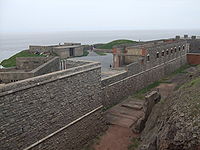
Photo from wikipedia
This paper presents two battery energy management (BEM) techniques for an electric vehicle (EV) traction system which incorporates an indirect field-oriented (IFO) induction motor (IM) drive system. The main objective… Click to show full abstract
This paper presents two battery energy management (BEM) techniques for an electric vehicle (EV) traction system which incorporates an indirect field-oriented (IFO) induction motor (IM) drive system. The main objective of the proposed BEM techniques is to regulate the IM’s speed while minimizing the lithium-ion (Li-ion) battery bank state of charge (SOC) reduction and state of health (SOH) degradation. In contrast to most of the existing work, the proposed BEM techniques operate without any prior knowledge of driving profiles or road information. The first BEM technique incorporates two cascaded fuzzy logic controllers (CSFLC). In CSFLC, the first fuzzy logic controller (FLC) generates the reference current signal for regulating the motor speed, while the second FLC generates a variable gain that limits the current signal variation based on the battery SOC. The second BEM technique is based on model predictive control (MPC) which generates the current signal for the speed regulation. However, this work introduces a new way of tuning the MPC input weight using battery information. It features a fuzzy tuned model predictive controller (FMPC), where an FLC adjusts the input weight in the MPC objective function such that the battery SOC is considered while generating the command current signal. Furthermore, this work utilizes a model-in-loop strategy comprising a Chen and Mora (CM) battery model and the experimentally obtained battery bank power consumption to estimate the increase in battery bank runtime and lifetime. A real-time implementation is carried out on a prototype EV traction system using the New European Drive Cycle (NEDC) and the Supplemental Federal Test Procedure (US06) drive cycles. The experimental results validate that the proposed CSFLC and FMPC BEM techniques exhibit a lower reduction in the battery SOC and SOH degradation, thus prolonging the battery bank runtime and lifetime as compared to the conventional FLC and MPC speed regulators. Further experimentation demonstrates the superiority of the FMPC technique over the CSFLC technique due to the lesser computational burden and higher average energy saving.
Journal Title: IEEE Access
Year Published: 2022
Link to full text (if available)
Share on Social Media: Sign Up to like & get
recommendations!